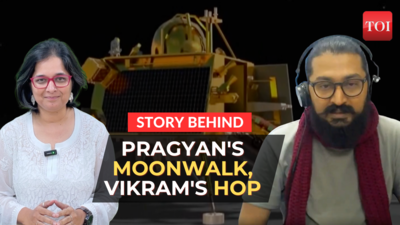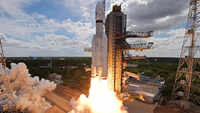- News
- India News
- Chandrayaan-3: Vikram kicked up over 2-tonne lunar soil, created 'ejecta halo'
Trending
This story is from October 27, 2023
Chandrayaan-3: Vikram kicked up over 2-tonne lunar soil, created 'ejecta halo'
The Vikram lander of Chandrayaan-3 created a "reflectance anomaly" or "ejecta halo" when it touched down on the Moon's surface on August 23. Scientists estimate that about 2.06 tonnes of lunar epi-regolith were ejected and displaced over an area of 108.4 m² around the landing site. By studying high-resolution images from the Chandrayaan-2 orbiter, researchers were able to characterize the ejecta halo. This discovery provides insights into lunar geology and the impact of lunar landings on the surface.

As Vikram descended and subsequently touched down on the lunar surface, it triggered the activation of its descent stage thrusters which resulted in the ejection of a substantial amount of lunar surficial epi-regolith (the top surface of the lunar soil or regolith) material, creating what scientists are now calling a “reflectance anomaly” or an ‘ejecta halo’.
“On August 23 as it descended, the Chandrayaan-3 lander module generated a spectacular ‘ejecta halo’ of lunar material. Scientists from NRSC (National Remote Sensing Centre) estimate that about 2.06 tonnes of lunar epi-regolith were ejected and displaced over an area of 108.4 m² around the landing site,” Isro said on Friday.
To investigate this phenomenon, scientists turned to the Orbiter High-Resolution Camera (OHRC) aboard the Chandrayaan-2 orbiter. They compared high-resolution panchromatic imagery acquired just hours before and after Vikram’s landing. The result was a detailed characterisation of the ‘ejecta halo,’ which appeared as an irregular bright patch encircling the lander.
This discovery sheds light on the behaviour of lunar materials during such events and opens up new avenues for research and understanding lunar geology.
Moreover, using empirical relations, scientists estimate that roughly 2.06 tonnes of lunar epiregolith were ejected during the landing event. This information provides valuable insights into the forces and dynamics involved in lunar landings and their impact on the lunar surface.
The findings are published in the Journal of the Indian Society of Remote Sensing, and is behind a paywall.

About the Author
Chethan KumarEnd of Article
FOLLOW US ON SOCIAL MEDIA










